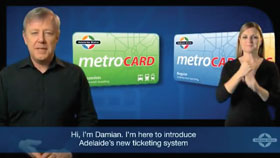Pre-journey planning generally takes place before someone leaves their location to start their public transport experience. It involves accessing information about public transport routes, service timetables and any required connections and conditions at the destination, from:
- online sources
- telephone services
- printed materials, or
- by asking someone (friends, family, customer service staff or others) to help provide this information.
People with disability have highlighted that a great deal of time and effort is required for pre-journey planning. People with accessibility requirements need to be confident that they can efficiently and safely complete their public transport journey. This is in contrast to other customers who can often make more spontaneous public transport travel decisions.
During this pre-journey phase, public transport users are seeking information to confirm the accessibility of all parts of the journey. Their decision making during this phase is also influenced by past experiences. Building confidence around the accessibility of the entire journey is key to enabling and encouraging more people to use public transport for their travel needs.
Aspirations for this journey part
- Encourage and enable more people to make informed decisions about using public transport.
- Reduce the amount of time it takes to pre-plan public transport journeys.
- Increase the confidence of public transport users that their journey will be seamless and safe.
How can we achieve this?
3.1.1 Providing a richer set of information/data in journey planning tools
People with disability have highlighted that they often have to use a number of customer service information resources, apps or other data sources to understand or confirm the accessibility of their journey. Adding additional data into regular journey planning apps—such as the accessibility status of stops, vehicles and interchanges—as well as information about the surrounding environment, provides the information people need to make informed decisions about their journey. This includes details on facilities available at the stop/station (such as a shelter), gradients, locations of steps, stairs, ramps (including kerb ramps), escalators and lifts, accessible car parking locations, footpath quality and continuity, gradient of ferry boarding points subject to tidal variation, and weather data.
Real-time information about the ‘busyness’ of the public transport system should be included in these tools so people can decide if they want to delay their journey for a quieter time. Information about delays and disruptions should also be included as they occur to allow continued planning en-route.
Journey planning tools should make use of this information and provide individualised planning information based on people's needs.
3.1.2 Provide information in a range of formats
People seek information in different formats. Tech savvy travellers often use apps for their journey planning, while others prefer to speak to customer service officers, use visual information sources, or read paper timetables and information at the public transport stop. However this is not always possible or appropriate for many users who can"t make use of technology for economic or practical reasons.
Currently, information about accessibility options is not always easy to find on transport and infrastructure provider websites. Communicating the availability of journey planning tools and assistance is an important whole-of-journey consideration.
Excerpt from submission on the draft guide by Blind Citizens Australia
“…smart phone applications have become an important method of accessing information for many people. For people who are blind or vision impaired, apps are extremely useful for those who feel confident in accessing them. However, an essential factor to take into account when designing services and infrastructure is that the majority of people who are blind or vision impaired, and are over the age of sixty-five, do not use a smart phone. Even when technology is accessible, the learning curve associated with adjusting to the use of screen-readers on phones and computers is long and steep for people who acquire vision loss later in life. Therefore, many people either choose not to use smart phone technology, or go through a lengthy period where it is not practical for them to do so.”
Links to information and journey accessibility planning tools and assistance can be improved by these being consistently located on service and infrastructure providers" websites. User testing by people with disability should always be a design consideration in relation to online information19.
Information should be provided in a range of formats to address the accessibility requirements of all users, and will need to include both technology based and more traditional formats. Simplicity is important for all users, but particularly for people who may have difficulty reading, who are deaf, those with a cognitive disability or those from non-English speaking backgrounds.
3.1.3 Safety
Safety and security can have a significant influence on user perceptions, and their comfort and confidence in using public transport. Information about public transport (including for the ‘pre-journey planning’ and ‘return journey planning’ stages), that informs users about stops and station facilities and staffing, helps support user planning and use of public transport.
3.1.4 Providing training
Some people with disability are comfortable using technology for journey planning, some are not. Organisations offering journey planning tools and apps should also provide training so people can set up and gain skills and confidence in using the apps and tools.
Opportunities for people to physically experience the public transport system in a controlled and comfortable environment through training sessions or open days could also be considered. These activities would build people's confidence and capacity to make decisions about public transport travel. The United Kingdom for example has produced a comprehensive Travel Training Good Practice Guide20 to facilitate this.
3.1.5 Customer service to cover the whole journey
Customer service staff should be trained and equipped to help people plan journey parts around their immediate area of responsibility. Being able to access information about the surrounding environment such as road closures or construction works can have a significant benefit to their customers and business. This is discussed further in section 3.7.
3.1.6 More consistency within the public transport system
The more consistent journeys are, the easier pre-journey planning will be. If people generally know where to seek travel information and what to expect along each part of their journey, they will have more confidence relying on past experiences to help inform their journey planning.
3.1.7 Address Web Content Accessibility Guidelines (WCAG)
Web Content Accessibility Guidelines21 (WCAG) are an internationally recognised standard that document how to make web content more accessible for people with disability. There are 12 guidelines organised under four principles: perceivable, operable, understandable and robust. Journey planning tools should meet each of these.
3.1.8 User involvement in tools development
Inclusion of people with disability is essential to developing and testing new apps and tools to make sure that they meet the needs of users.
| Online ‘plan a journey’ and training tools Trip planning results and timetables on the Transport for NSW website use notes to show accessible trips. Customers with disability can plan their trips using only accessible services. A-‘location facilities’ search tool has been introduced that lists facilities (including accessible features) at stations, interchanges and wharves. This is complemented by the First Stop Transport eLearning module developed for anyone wanting to learn how to use public transport. The module also incorporates training materials for those seeking accreditation as a travel trainer through a Registered Training Organisation. |
 Figure 1—Transport for NSW Online trip planning22 © Transport for NSW |
| Adelaide Metro's smartcard introduction videos The Adelaide Metro website has a series of videos that introduce its new smartcard ticketing system. The information is provided in a range of formats including spoken, plain English, subtitles, images and photographs, with on-screen AUSLAN interpreting for all content. These multiple formats cover a wide range of information needs. |
 Figure 2—Video clips to introduce smartcard ticketing system23 © Adelaide Metro (Creative Commons) |
| The Rocks precinct accessibility maps Sydney's Rocks accessibility map is a good example of a precinct-wide approach to accessibility information. It provides information about routes through the precinct that are and aren"t accessible, and details accessible paths, lifts and bathrooms. It also includes information about public transport options within the precinct. |
 Figure 3—The Rocks accessibility map24 © Sydney Harbour Foreshore Authority |
19 Vision Australia submission on the draft guide.
20www.gov.uk/government/uploads/system/uploads/attachment_data/file/4482/guidance.pdf
21www.w3.org/WAI/intro/wcag.php
22tp.transportnsw.info/nsw/XSLT_TRIP_REQUEST2?language=en
23www.youtube.com/watch?v=lvmcCiRVzHo
24www.therocks.com/media/141657/c4f853b8-d9d7-c228-b1d9697fdc0d8c6d.pdf